Maryland
state, United States
Introduction
Maryland, flag of
 constituent state of the United States of America (United States). One of the original 13 states, it lies at the centre of the Eastern Seaboard, amid the great commercial and population complex that stretches from Maine to Virginia. Its small size belies the great diversity of its landscapes and of the ways of life that they foster, from the low-lying and water-oriented Eastern Shore and Chesapeake Bay area, through the metropolitan hurly-burly of Baltimore, its largest city, to the forested Appalachian (Appalachian Mountains) foothills and mountains of its western reaches.
constituent state of the United States of America (United States). One of the original 13 states, it lies at the centre of the Eastern Seaboard, amid the great commercial and population complex that stretches from Maine to Virginia. Its small size belies the great diversity of its landscapes and of the ways of life that they foster, from the low-lying and water-oriented Eastern Shore and Chesapeake Bay area, through the metropolitan hurly-burly of Baltimore, its largest city, to the forested Appalachian (Appalachian Mountains) foothills and mountains of its western reaches.

 constituent state of the United States of America (United States). One of the original 13 states, it lies at the centre of the Eastern Seaboard, amid the great commercial and population complex that stretches from Maine to Virginia. Its small size belies the great diversity of its landscapes and of the ways of life that they foster, from the low-lying and water-oriented Eastern Shore and Chesapeake Bay area, through the metropolitan hurly-burly of Baltimore, its largest city, to the forested Appalachian (Appalachian Mountains) foothills and mountains of its western reaches.
constituent state of the United States of America (United States). One of the original 13 states, it lies at the centre of the Eastern Seaboard, amid the great commercial and population complex that stretches from Maine to Virginia. Its small size belies the great diversity of its landscapes and of the ways of life that they foster, from the low-lying and water-oriented Eastern Shore and Chesapeake Bay area, through the metropolitan hurly-burly of Baltimore, its largest city, to the forested Appalachian (Appalachian Mountains) foothills and mountains of its western reaches.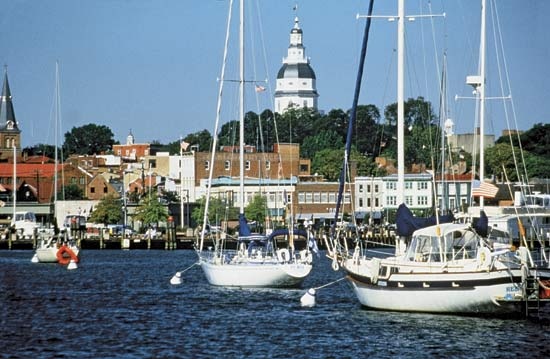 Maryland was named in honour of Henrietta Maria, the wife of King Charles I, by a grateful Cecilius (Cecil) Calvert, 2nd Baron Baltimore, who was granted a charter for the land in 1632. Annapolis, the state capital, lies on Chesapeake Bay, roughly equidistant from Baltimore (north) and Washington, D.C. (Washington) (west).
Maryland was named in honour of Henrietta Maria, the wife of King Charles I, by a grateful Cecilius (Cecil) Calvert, 2nd Baron Baltimore, who was granted a charter for the land in 1632. Annapolis, the state capital, lies on Chesapeake Bay, roughly equidistant from Baltimore (north) and Washington, D.C. (Washington) (west).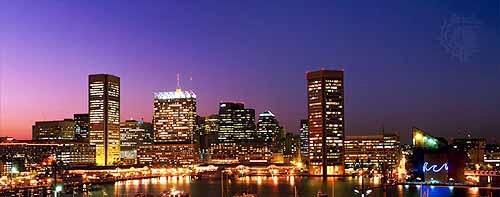 Geography has provided Maryland a role in U.S. history as a pivot between the North and the South. Its northern border with Pennsylvania is the famous Mason and Dixon Line, drawn in the 1760s to settle disputes between the Penn and Calvert families and traditionally regarded as the boundary between the North and the South. To the south much of the boundary with Virginia is formed by the Potomac River, a symbolic barrier during the American Civil War. On the north bank of the Potomac lies the District of Columbia (coterminous with the city of Washington, D.C.), a small enclave ceded by Maryland in 1791 for the site of the national capital. East of the Chesapeake, the Eastern Shore shares the Delmarva Peninsula with Delaware on the north and Virginia on the south. In the mountainous west is Maryland's panhandle, which is joined to the rest of the state by a narrow waist and interlocks with the eastern panhandle of West Virginia. Area 10,454 square miles (27,076 square km). Pop. (2000) 5,296,486; (2007 est.) 5,618,344.
Geography has provided Maryland a role in U.S. history as a pivot between the North and the South. Its northern border with Pennsylvania is the famous Mason and Dixon Line, drawn in the 1760s to settle disputes between the Penn and Calvert families and traditionally regarded as the boundary between the North and the South. To the south much of the boundary with Virginia is formed by the Potomac River, a symbolic barrier during the American Civil War. On the north bank of the Potomac lies the District of Columbia (coterminous with the city of Washington, D.C.), a small enclave ceded by Maryland in 1791 for the site of the national capital. East of the Chesapeake, the Eastern Shore shares the Delmarva Peninsula with Delaware on the north and Virginia on the south. In the mountainous west is Maryland's panhandle, which is joined to the rest of the state by a narrow waist and interlocks with the eastern panhandle of West Virginia. Area 10,454 square miles (27,076 square km). Pop. (2000) 5,296,486; (2007 est.) 5,618,344.Land (Maryland)
Relief

 The Coastal Plain covers about half of Maryland's land area, yielding to the region called the Piedmont Plateau at a fall line running from the northern tip of the District of Columbia through Baltimore and to near the northeastern corner of the state. The Catoctin ridgeline in the west forms the gateway to the Appalachians.
The Coastal Plain covers about half of Maryland's land area, yielding to the region called the Piedmont Plateau at a fall line running from the northern tip of the District of Columbia through Baltimore and to near the northeastern corner of the state. The Catoctin ridgeline in the west forms the gateway to the Appalachians.The Eastern Shore, the area east of Chesapeake Bay, is flat with extensive wetlands. The maximum elevation there is 100 feet (30 metres) above sea level. The area west of the Chesapeake, called the Western Shore, is generally flat, but some low hills reach heights of 300 to 400 feet (90 to 120 metres). Most of the Coastal Plain is farmland with small rural communities, except for the urban areas of Baltimore, Washington, D.C., Salisbury, and Ocean City.
Maryland's share of the Appalachian Mountains comprises a series of forested barriers, with many of the intervening valleys still uncleared. Backbone Mountain, hugging the West Virginia line, is the highest point in Maryland, at 3,360 feet (1,024 metres).
Drainage and soils
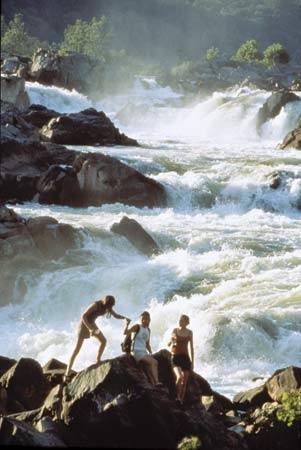 To the south the Coastal Plain is sandy; to the north it is loamy and fertile. Its water edges—consisting of salt marshes, or wetlands—exasperate mapmakers as erosion periodically fills in a swamp or deletes an entire island: St. Clements Island (Saint Clements Island) (also called Blakiston Island), for example, is about one-tenth the size it was in 1634. The Chesapeake's some two dozen estuarial tributaries provide the state with about 3,200 miles (5,150 km) of shoreline—subject to frequent change. The most important of nature-made revisions was an irruption of the ocean, during a storm in 1933, through Assateague Island, a sand barrier island on the Atlantic shore, dividing it in two. The northern portion, Fenwick Island, now has at its southern end the resort town of Ocean City, formerly located mid-island. The southern portion is now Assateague Island National Seashore, whose territory is shared with the state of Virginia. The inlet between the two islands has become a boon to Ocean City's resort fishing fleet. It has been kept open by regular dredging by the U.S. Army Corps of Engineers.
To the south the Coastal Plain is sandy; to the north it is loamy and fertile. Its water edges—consisting of salt marshes, or wetlands—exasperate mapmakers as erosion periodically fills in a swamp or deletes an entire island: St. Clements Island (Saint Clements Island) (also called Blakiston Island), for example, is about one-tenth the size it was in 1634. The Chesapeake's some two dozen estuarial tributaries provide the state with about 3,200 miles (5,150 km) of shoreline—subject to frequent change. The most important of nature-made revisions was an irruption of the ocean, during a storm in 1933, through Assateague Island, a sand barrier island on the Atlantic shore, dividing it in two. The northern portion, Fenwick Island, now has at its southern end the resort town of Ocean City, formerly located mid-island. The southern portion is now Assateague Island National Seashore, whose territory is shared with the state of Virginia. The inlet between the two islands has become a boon to Ocean City's resort fishing fleet. It has been kept open by regular dredging by the U.S. Army Corps of Engineers.The Piedmont Plateau has good farming soil except for belts of clay that are mined for brick kilns; from early colonial times, the exteriors of Maryland buildings have glowed with salmon-coloured brick made from these clay deposits. To the west and parallel to the fall line, the low Parr's Ridge forms a drainage divide separating water flow east to the Chesapeake and southwest to the Potomac River.
The most salient feature of Maryland's topography is Chesapeake Bay, which serves the port of Baltimore, divides the Eastern Shore from what was once called Maryland Main, and covers some 1,840 square miles (4,770 square km). On a summer weekend as many as 100,000 sailboats and powerboats may be seen on the water. But the bay has its drawbacks. Swimmers shun its brackish, murky water after the late-summer onset of billions of small stinging jellyfish, and the cross-bay bridges are often filled to capacity with the crush of summer weekenders going to and coming from the ocean beaches.
Dredging is also necessary to maintain the 50-foot- (15-metre-) deep ship channel to Baltimore and to the Chesapeake and Delaware Canal, which connects the northern end of the Chesapeake to the Delaware River. The bay must also be protected against pollution by the municipalities, industries, and farms in its drainage area. The floor of the bay was once lined with oysters, but silt, pollutants, and hostile microorganisms have pushed the beds up into tributary rivers and diminished the yield even there. The largest catch is the blue crab, which arrives on dinner tables in such forms as crab soup, crab cakes, steamed hard-shell crabs, soft-shell crabs, and crab imperial. The bay, which was called by journalist and critic H.L. Mencken (Mencken, H.L.) a “great big outdoor protein factory,” still affords a precarious living to hundreds of people who live and work on the water.
Climate
Maryland has two climates. It is continental in the highland west, with temperature records from −40 °F (−40 °C) to more than 100 °F (38 °C). Average temperatures in western Maryland are 65 °F (18 °C) in July and 28 °F (−2 °C) in January. The east has a humid subtropical climate strongly influenced by Chesapeake Bay and the Atlantic Ocean, both of which moderate the weather but do not prevent ice formation almost every winter on the bay's northern tributaries; summer calms can produce high temperatures up to 107 °F (42 °C), with nearly 100 percent relative humidity. Average temperatures in eastern Maryland are 75 °F (24 °C) in July and 35 °F (2 °C) in January. Ordinarily, precipitation levels are enough to make reservoirs overflow and to enable Baltimore and Washington, D.C., to draw all the soft water needed for municipal supplies. Storms sweep in from the west and south, except in late summer, when the fringes of passing hurricanes often drench Maryland from the east.
Plant and animal life
Before the arrival of European colonists in 1634, Maryland's natural vegetation was quite different from what it is today. At that time about nine-tenths of Maryland was forested (forest), but over the centuries people cleared, plowed, and urbanized the landscape, and by the early 21st century only some two-fifths of the state remained forested. Still, Maryland has more than 150 tree species. Oak and hickory are by far the most dominant types, constituting about two-thirds of the forests.
The Eastern Shore was formerly an area of oak, pine, cypress, and gum forests, and on the Western Shore there were oak, hickory, and pine forests. Today the Coastal Plain, primarily on the Eastern Shore, is largely cleared, and the forests that do exist reflect the mild climatic influences of Chesapeake Bay and the Atlantic Ocean. Bald cypress and loblolly pine are common, generally representing the northern limit of these trees. The Piedmont area was forested by chestnut, walnut, hickory, oak, and pine; today it is dominated by oak, yellow poplar, ash, and some pine. In western Maryland the pattern was pine and chestnut on hilltops, with oak, poplar, maple, and walnut in the valleys; now the mountains and valleys are forested by oaks and other hardwoods (beech, birch, and maple).
Maryland is an ecologically diverse state that supports a wide variety of wildlife species, some of which are abundant enough to allow economic activities such as the Chesapeake Bay fishery, but over the centuries the loss and degradation of wildlife habitats to development has greatly diminished this diversity. Elk, bison, wolves, and cougars disappeared from Maryland in the 18th and 19th centuries. As the human population has grown and pressures for development have intensified, it has become difficult, yet critical, to protect wildlife habitats. In addition to development, there are threats from global warming (including potential climate change and rises in sea level) and air and water pollution. The Maryland Department of Natural Resources' Natural Heritage Program monitors the status of more than 1,100 native plants and animals. Particular attention is focused on species such as the blue crab and the Chesapeake Bay oyster.
People
Population (Maryland) composition
The white population, at first all originating from the British Isles, began to vary when German-speaking farmers and artisans moved from Pennsylvania into western Maryland during the 1700s. The process accelerated in the 1840s during the Irish Potato Famine and as Germans and German Jews fled military conscription, and then Russian Jews, Poles, Czechs, Italians, Greeks, and others arrived at Baltimore—a major 19th-century immigration centre—and later fanned out into the countryside. Ethnic diversity was one of the first characteristics that set Maryland apart from the regions south of the Potomac River. Immediately after the American Civil War, this diversity was countered by an influx of Southerners who despaired of life in a defeated and devastated homeland. Many former slaves moved north to Baltimore, where they joined a well-established African American community who had been free for several generations.
Maryland's Native American population had been mostly extinguished or pushed westward by about 1700. All that remains from their centuries of habitation are campsite artifacts, still being unearthed; some notable bayside oyster middens; and place-names corrupted by uncomprehending whites, such as Chesapeake, Patapsco, Potomac, Wicomico, Patuxent, Piscataway, and Susquehanna.
African slaves (slavery) laboured in Maryland from the time of the first Calverts. The consciences of many Marylanders, particularly members of the Society of Friends (Friends, Society of) (Quakers), were uneasy; from 1783 the importation of kidnapped Africans was heavily taxed. While Maryland did not formally outlaw slavery until 1864, it protected the liberty of more free blacks than any other state as slavery neared its end. After the Civil War, blacks found Maryland more congenial than the states of the former Confederacy (Confederate States of America), in which, by 1900, systematic lifetime disfranchisement of blacks was under way. A similar effort in Maryland, led by the Democratic Party and coming to a head in 1910, was defeated in referendum by Republicans (Republican Party). Yet it took a U.S. Supreme Court (Supreme Court of the United States) decision in 1934 to force the University of Maryland (Maryland, University of) to admit a black student into its school of law, and it was 1970 before Marylanders sent a black representative (from a district that included Baltimore) to the U.S. Congress (Congress of the United States). The latter development reflected in part the changing population of Baltimore, now more than half African American.
In the early 21st century whites constituted about two-thirds of the state's total population, and African Americans made up nearly one-third. Most of the remainder were Asian Americans, with a small number of Native Americans. The state also has a small but growing Hispanic population.
Settlement patterns
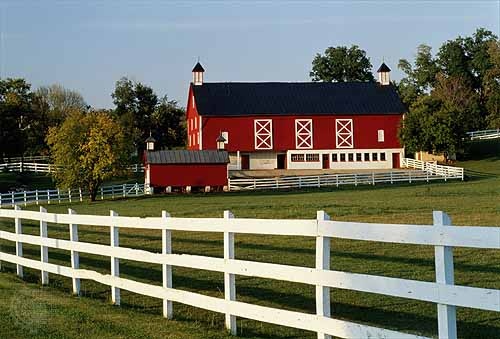 Baltimore has continued to lose people to the suburbs. From a population of some three-quarters of a million in 1990, it had declined to about 600,000 by midway through the next decade. Calculations for the next largest cities are impeded by the tendency of municipalities not to incorporate; thus, boundary lines are drawn arbitrarily by census takers. There are only some 150 incorporated cities and towns in Maryland.
Baltimore has continued to lose people to the suburbs. From a population of some three-quarters of a million in 1990, it had declined to about 600,000 by midway through the next decade. Calculations for the next largest cities are impeded by the tendency of municipalities not to incorporate; thus, boundary lines are drawn arbitrarily by census takers. There are only some 150 incorporated cities and towns in Maryland.Sectionalism within Maryland is dictated by terrain. The Eastern Shore farmers concentrate on chickens, corn (maize), and soybeans; the factory-style output of broilers (young chickens) is immense. A mercantile appendage of Wilmington, Del., and Philadelphia until the bay was bridged in 1952, the nine-county Eastern Shore has become a vacation and retirement spot for the affluent, who appreciate the privacy of its flat, wooded, little-traveled estate areas serpentined with creeks, coves, guts, necks, and inlets.
Southern Maryland's five counties on the Western Shore (Anne Arundel, Prince George's, Calvert, Charles, and St. Mary's) have built a way of life around state government, tobacco growing, military installations, and, increasingly, residential areas for Washingtonians. Thus, Prince George's county, almost one big suburb, has become—along with Montgomery county—one of Maryland's two most populous counties.
Central Maryland comprises the city of Baltimore and five counties. Four of the counties contain most of Baltimore's suburbs; the fifth is Montgomery, on the northwestern edge of Washington, D.C. Only about one-sixth of Marylanders live outside metropolitan areas. Central Maryland is one long, contiguous metropolitan area that stretches from Baltimore to Washington, D.C., and reaches over the Bay Bridge to the Eastern Shore to include Queen Anne's county.
The four counties of western Maryland owe much to road, railroad, and canal builders. The barging of coal and grain ceased in 1924, but the creation of the Chesapeake and Ohio Canal National Historical Park in 1971 assured a stream of excursionists. Interstate and national roads carry city dwellers to Garrett county, where mountainside ski runs complement aquatic sports on Deep Creek Lake, the largest man-made body of water in the state.
The heaviest concentrations of population are around Washington, D.C., and Baltimore. The stretch between the two cities, which are only 40 miles (65 km) apart, has become urbanized—although the growth outward from the cities has been uneven—and has fused to create one of the largest metropolitan areas in the United States.
Between Washington and Baltimore proper is the planned, nationally watched city of Columbia, in Howard county. Created only in the mid-1960s, Columbia was approaching its intended population of some 100,000 four decades later. The city is unincorporated, governed by a private association rather than an elected government. A community not only of cars and shopping malls but also with ample greenery and other amenities, Columbia is slightly closer to Baltimore, although a majority of its residents work in or near Washington, D.C. Many jobs in Maryland's high-technology industries are located close to Columbia along Interstate 95.
Economy
Service businesses employ a higher proportion of the total workforce than any other sector of the economy, and agriculture directly supports only a small number of people. The state has taken an increasing interest in the well-being of the private sector, particularly through its Department of Business and Economic Development. The agency encourages outside firms to locate in Maryland, promotes tourism, and keeps a close watch on the economy of the state. Maryland's biotechnology, aerospace, information technology, and other high-technology industries made it one of the leading states in the knowledge- and information technology–based “new economy” of the late 20th and early 21st centuries.
The major manufactures are primary metals, electronic and electrical equipment, transportation equipment, chemicals, and food and kindred products. Another important industry is printing and publishing. Most large establishments are branches of out-of-state corporations, but wages for production workers are slightly above the national average. Electricity is generated at a nuclear plant at Calvert Cliffs; western Maryland coal mining ebbed but made something of a comeback with the national trend of rising energy costs in the early 21st century.
Maryland has one category of nationwide preeminence in terms of production: crabs (crab). The state's crab haul consistently has surpassed that of other states, although there has been a marked decline in the catch since the late 1990s. Saltwater staples also include other shellfish (notably oysters), as well as perch, flounder, and other finfish.
In its early history Maryland was an agricultural colony, its main crop being tobacco. Manufacturing replaced agriculture as the dominant economic activity in the late 19th century. By the early 21st century only a small proportion of the gross state product came from agricultural products. The principal crops are greenhouse and nursery products, soybeans, and corn (maize).
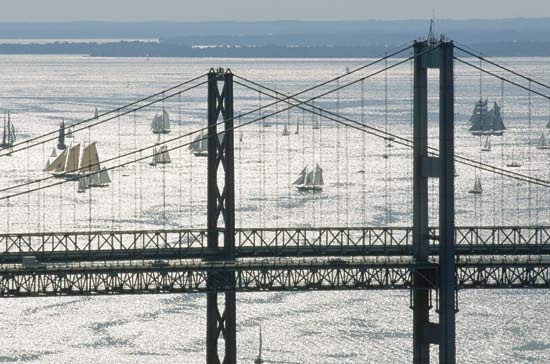 Maryland has a well-developed network of high-speed interstate highways, especially in the corridor between Baltimore and Washington, D.C. It is possible to swing around Baltimore and Washington on ring-road beltways or to avoid them altogether by Eastern Shore routes. The Harbor Tunnel Thruway, Francis Scott Key Bridge, and Fort McHenry Tunnel provide routes across Baltimore's harbour. The Potomac is spanned at several places around Washington, and two bridges traverse the Chesapeake east of Annapolis.
Maryland has a well-developed network of high-speed interstate highways, especially in the corridor between Baltimore and Washington, D.C. It is possible to swing around Baltimore and Washington on ring-road beltways or to avoid them altogether by Eastern Shore routes. The Harbor Tunnel Thruway, Francis Scott Key Bridge, and Fort McHenry Tunnel provide routes across Baltimore's harbour. The Potomac is spanned at several places around Washington, and two bridges traverse the Chesapeake east of Annapolis. Amtrak provides passenger rail service to Baltimore, and residents of Montgomery and Prince George's counties can commute to Washington, D.C., on the Metro rapid-transit rail system; in addition, the Maryland Rail Commuter Service (MARC) connects Baltimore and Frederick to Washington. Baltimore too has built a rapid-transit commuter system—between Owings Mills, a northwest suburb, and downtown. Baltimore/Washington International Thurgood Marshall Airport (BWI) is a major regional hub and is augmented by numerous public airports throughout the state. The port of Baltimore has excellent facilities for freight shipments and is one of the country's busiest ports. Operations there, supervised by a state agency, are especially well adapted for bulk commodities, container shipments, and foreign-made automobiles.
Government and society
Constitutional framework
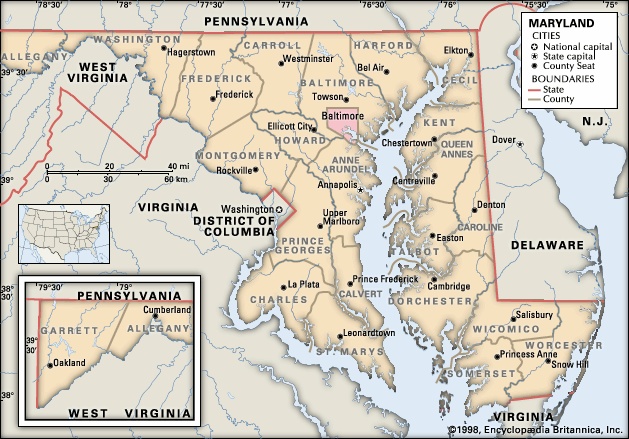

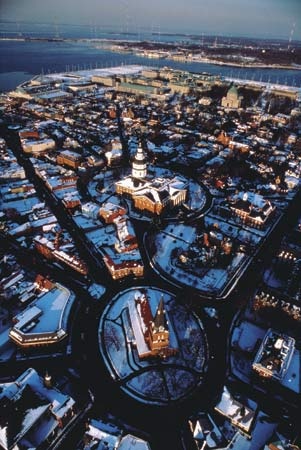 In spite of a provision for statewide voting every 20 years on whether to summon a constitutional convention, repeated attempts to scrap the 1867 document—with its unnecessary detail, obsolete concerns, and silence on points of present-day interest—have failed. The document has been amended some 200 times, however.
In spite of a provision for statewide voting every 20 years on whether to summon a constitutional convention, repeated attempts to scrap the 1867 document—with its unnecessary detail, obsolete concerns, and silence on points of present-day interest—have failed. The document has been amended some 200 times, however.The governor, who serves for four years, may be reelected to an immediately succeeding term only once. A 1969–72 reorganization of the state government brought together in 12 departments several hundred separate agencies, boards, and commissions.
The bicameral state legislature, the General Assembly, consists of the Senate, with 47 members, and the House of Delegates, with 141 members. Members of each chamber serve terms of four years and may be reelected indefinitely. Reorganization in the 1960s ended rural domination of the legislature and passed power to the counties adjoining Baltimore and Washington, D.C.
The seven-member Court of Appeals is the highest judicial body; below that are an intermediate Court of Special Appeals and circuit and district courts, as well as an Orphans' Court, which handles wills, estates, and other probate matters. Judges are appointed by the governor; to retain their positions, however, they must run against their records in the next election following their appointment, and, in Baltimore, circuit court judges must run against anyone filing in opposition. Appeals judges are elected to 10-year terms and circuit judges to 15-year terms.
To avoid the greater costs that would be entailed by incorporation as governmental bodies, many of Maryland's most-populous areas remain unofficial entities, their services provided on a countywide basis. The emphasis in Maryland has historically been on county-level government, which provides most local services. A constitutional amendment allows home rule for counties, under special charter. A charter county is governed by a county executive and county council, both elected to four-year terms; the council is empowered to enact all local laws. Eleven mostly rural counties are still governed by elected boards of county commissioners. The city of Baltimore, a separate jurisdiction, is run by an elected mayor and city council and a mostly appointive Board of Estimates.
Beginning in the 20th century, Maryland elections, although free of the intimidation, poll tax, and other impediments to enfranchisement that were practiced in some places in the South, were often dominated by machine politics. The larger group of voters consistently has registered as Democrats, and the Democratic Party usually, but not always, has dominated elections. A Republican (Republican Party) nominee can expect to do well in the western counties, one or two southern enclaves, the Eastern Shore, and some affluent parts of suburban Maryland. Baltimore, with its party-boss tradition, is a Democratic stronghold.
Numerous presidential-nominating conventions assembled in Baltimore in the 19th century, but none has been held there since 1912. In 1969 Marylanders chose their first Jewish governor, in 1970 their first black congressman, and in 1986 their first female U.S. senator.
Through its revenues, largely derived from an income tax, federal aid, retail sales taxes, and a lottery, the state has assumed responsibilities that are no longer within the capacity of the local government. The state pays all full-time judges; a state committee approves the construction of all public school buildings; and the state-run Maryland Aviation Administration operates BWI. The state provides annual subsidies to Baltimore's leading orchestra, art museum, public library, and resident theatre. In many instances, as population and industry have moved outward, as old structures have been demolished and property tax assessments and yield have dipped, municipalities have taken the initiative in this transfer of responsibilities to the state.
Health and welfare
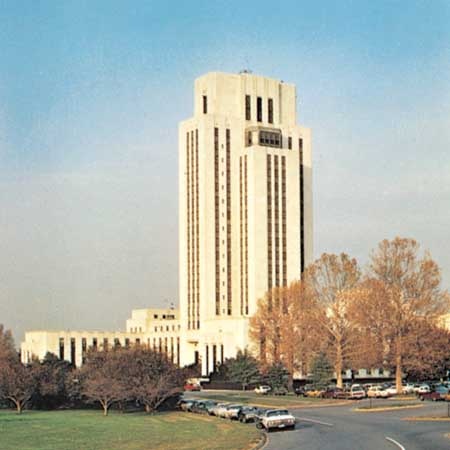 Health care is a major economic activity in Maryland. Baltimore has become a renowned health care and medical research centre, with notable facilities at the Johns Hopkins University and University of Maryland (Maryland, University of) hospitals. The National Naval Medical Center in Bethesda is one of the country's best-known military medical facilities and oversees the health care of U.S. presidents.
Health care is a major economic activity in Maryland. Baltimore has become a renowned health care and medical research centre, with notable facilities at the Johns Hopkins University and University of Maryland (Maryland, University of) hospitals. The National Naval Medical Center in Bethesda is one of the country's best-known military medical facilities and oversees the health care of U.S. presidents.The Department of Health and Mental Hygiene, in addition to supervising county services, provides for the treatment of alcoholism, drug abuse, developmental disabilities, mental illness, and other health and behavioral problems. The department is also active in preventive medicine—for instance, providing programs of education against drug abuse. The state's Shock Trauma Center at the University of Maryland Medical Center in Baltimore conveys the severely injured from anywhere in the state by helicopter within one hour for immediate lifesaving treatment.
The Department of the Environment is the centre for state efforts to prevent or reduce pollution. It monitors the state's water supply and sewage, air quality, and solid-waste disposal.
The Department of Human Resources is in charge of state welfare activities. Direct aid to families with dependent children is its largest outlay, followed by general public assistance and foster care.
Education
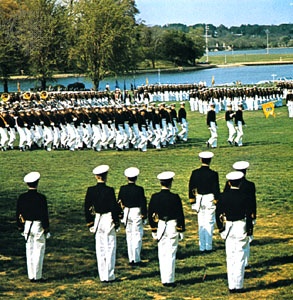 Control of public education in Maryland is vested in a state board of education, a board of higher education, and Baltimore and county school boards. In most counties board members are elected to office, but in the rest the boards are appointed. State supervision and the support of county public school systems began in 1870, but not until 1951 was 12 years' schooling uniformly required of children in all counties of the state. The state supports local systems, particularly regarding library services, vocational and rehabilitative instruction, and utilization of federal aid.
Control of public education in Maryland is vested in a state board of education, a board of higher education, and Baltimore and county school boards. In most counties board members are elected to office, but in the rest the boards are appointed. State supervision and the support of county public school systems began in 1870, but not until 1951 was 12 years' schooling uniformly required of children in all counties of the state. The state supports local systems, particularly regarding library services, vocational and rehabilitative instruction, and utilization of federal aid.There are two-year community colleges in Baltimore and in several other locations. Crowning the state's system of higher education is the University of Maryland (Maryland, University of), with its main campus in College Park and branches located in Baltimore, Catonsville, and Princess Anne. The university had its origins in the College of Medicine of Maryland (opened 1807) and Maryland Agricultural College (1856). The several graduate and undergraduate schools of the University of Maryland were consolidated in 1920, and in enrollment it has become one of the country's largest universities. In 1988 the University System of Maryland (Maryland, University of) was created by combining the various state-supported campuses, including that at College Park, under an overarching administrative entity.
Maryland has several private institutions of higher learning. The most prominent of these are Johns Hopkins University (founded 1876), with several campuses, a world-renowned medical school, and the Peabody Institute, a music school; St. John's College (Saint John's College) (1784) in Annapolis, noted for its emphasis on the great books of the Western world; Goucher College (1885) in Towson; and the Maryland Institute College of Art (1826), in Baltimore. In addition, the United States Naval Academy (1845) is at Annapolis.
Cultural life
 Maryland has its share of such nationwide phenomena as the decay of cities, little restraint on commercial development in some suburban and rural areas, and loss of local cultural distinctiveness. Yet Maryland has become a recognized national leader in the fight against urban decay and sprawl. “Smart growth” laws have encouraged the redevelopment of unused urban space. Programs have been put in place to slow down the conversion of farmland and forests to residential development. Smart growth has been intended not to halt growth but to channel it into existing urban and suburban areas.
Maryland has its share of such nationwide phenomena as the decay of cities, little restraint on commercial development in some suburban and rural areas, and loss of local cultural distinctiveness. Yet Maryland has become a recognized national leader in the fight against urban decay and sprawl. “Smart growth” laws have encouraged the redevelopment of unused urban space. Programs have been put in place to slow down the conversion of farmland and forests to residential development. Smart growth has been intended not to halt growth but to channel it into existing urban and suburban areas.At the same time, Marylanders have kept alive the state's traditional interests through their enthusiasm for distinctive activities such as steeplechasing in the Grand National and Maryland Hunt Cup races, breeding Chesapeake Bay retrievers (Chesapeake Bay retriever), and jousting on horseback with a spear at rings dangling from a crossbar; jousting is Maryland's official state sport. In almost a different world are the tiny communities located on various islands of Chesapeake Bay, in which isolation has worked to preserve distinct attitudes and ways of life.
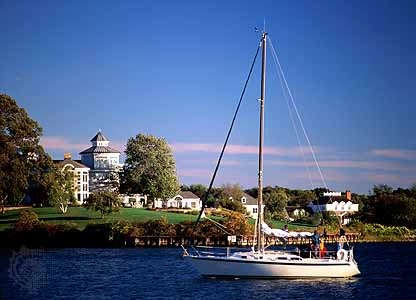 The outdoors looms large in the life of Marylanders. Popular activities include sailing and crabbing on the bay, trolling for ocean marlin, shooting wild ducks and geese in the marshes of the Eastern Shore, playing the game of lacrosse (derived from an Indian sport), beachcombing for fossil shark teeth at Calvert Cliffs, exploring mountain caves, skiing and whitewater rafting in western Maryland, and hiking the 38-mile (61-km) stretch of the Appalachian Trail (Appalachian National Scenic Trail) across Maryland.
The outdoors looms large in the life of Marylanders. Popular activities include sailing and crabbing on the bay, trolling for ocean marlin, shooting wild ducks and geese in the marshes of the Eastern Shore, playing the game of lacrosse (derived from an Indian sport), beachcombing for fossil shark teeth at Calvert Cliffs, exploring mountain caves, skiing and whitewater rafting in western Maryland, and hiking the 38-mile (61-km) stretch of the Appalachian Trail (Appalachian National Scenic Trail) across Maryland. Sailboat and sports-car racing attracts both participants and spectators. Audiences that include both Maryland residents and those from beyond the state's borders are drawn to a variety of other sporting events. Notable are the horse-racing (horse racing) venues at Laurel, Bowie, and Pimlico, the latter the home of the annual Preakness Stakes (May). Baltimore has a professional baseball team, the Orioles, and gridiron football team, the Ravens. Restaurants present a plethora of cuisines, but the traditional gastronomy of Maryland tends to be centred on terrapin soup, steamed crabs, padded oysters (fried oyster patties), fish and crab cakes, and beaten biscuits (Southern-style unleavened biscuits), often accompanied by Maryland rye and beer.
Sailboat and sports-car racing attracts both participants and spectators. Audiences that include both Maryland residents and those from beyond the state's borders are drawn to a variety of other sporting events. Notable are the horse-racing (horse racing) venues at Laurel, Bowie, and Pimlico, the latter the home of the annual Preakness Stakes (May). Baltimore has a professional baseball team, the Orioles, and gridiron football team, the Ravens. Restaurants present a plethora of cuisines, but the traditional gastronomy of Maryland tends to be centred on terrapin soup, steamed crabs, padded oysters (fried oyster patties), fish and crab cakes, and beaten biscuits (Southern-style unleavened biscuits), often accompanied by Maryland rye and beer.Among Marylanders who have made major contributions to artistic and intellectual traditions are H.L. Mencken, the black abolitionist-statesman Frederick Douglass (Douglass, Frederick), the antislavery activist Harriet Tubman (Tubman, Harriet), the philanthropists George Peabody (Peabody, George), Johns Hopkins (Hopkins, Johns), Enoch Pratt, and Henry Walters, and, in the 20th and 21st centuries, the novelists Anne Tyler (Tyler, Anne) and John Barth (Barth, John) and the filmmakers Barry Levinson and John Waters.
 Baltimore is the centre of much of the state's activity in the arts. It is the home of the Baltimore Symphony Orchestra and of several professional theatres, including the France-Merrick Performing Arts Center at the Hippodrome, Center Stage, Theatre Project, and numerous suburban dinner theatres. The Baltimore Museum of Art, Walters Art Museum, Maryland Historical Society, National Aquarium, U.S. sloop of war Constellation, Maryland Science Center, Baltimore & Ohio Railroad Museum, Baltimore Streetcar Museum, and Baltimore Museum of Industry are supplemented by galleries and display centres elsewhere, as well as by fairs and festivals. The most notable among them is the Maryland State Fair, which takes place in late summer at the State Fairgrounds in Timonium, north of Baltimore. Tourists throng to Baltimore's Inner Harbor year-round. Developed mostly in the 1980s, the Inner Harbor is a waterside array of stores, hotels, performances, moving boats, docked ships, and venues for eating and drinking.
Baltimore is the centre of much of the state's activity in the arts. It is the home of the Baltimore Symphony Orchestra and of several professional theatres, including the France-Merrick Performing Arts Center at the Hippodrome, Center Stage, Theatre Project, and numerous suburban dinner theatres. The Baltimore Museum of Art, Walters Art Museum, Maryland Historical Society, National Aquarium, U.S. sloop of war Constellation, Maryland Science Center, Baltimore & Ohio Railroad Museum, Baltimore Streetcar Museum, and Baltimore Museum of Industry are supplemented by galleries and display centres elsewhere, as well as by fairs and festivals. The most notable among them is the Maryland State Fair, which takes place in late summer at the State Fairgrounds in Timonium, north of Baltimore. Tourists throng to Baltimore's Inner Harbor year-round. Developed mostly in the 1980s, the Inner Harbor is a waterside array of stores, hotels, performances, moving boats, docked ships, and venues for eating and drinking.A deep sense of history is evident in the quiet charm of Annapolis. Designated the colonial capital in 1694, it is notable for its white-domed, pillared statehouse, built in 1772, the country's oldest such structure in continuous use. The city's 40-block Colonial Historic District contains more structures dating from before the American Revolution than any other U.S. historic district. The narrow, crooked streets of Annapolis, the houses abutting directly on the brickwork sidewalks, the graceful tree-covered green about the statehouse, and the myriad masts of boats at dock or at anchor in the harbour reflect more an earlier America than a state geared to the latest in technology
Daily newspapers include the Baltimore Sun and the Annapolis Capital. Several smaller cities also publish daily and weekly papers. The Daily Record is a statewide source for business and legal news. Baltimore, Annapolis, Frederick, Hagerstown, and Salisbury have commercial and public television stations.
History (Maryland)
The area's earliest human occupation is accepted as having been by roving hunters about 10,000 BC, as the Pleistocene ice sheet made its final retreat. The records of this pre-Archaic (Archaic culture), fluted-blade culture, which left only the points of its weapons, remain imprecise. Later, the numerous Eastern Archaic populations practiced agriculture and feasted on seafood. By AD 1000 the Archaic culture had developed into the Woodland (Woodland cultures), notable for concentrated villages and elaborate ceremonial practices. This culture continued into the period of European settlement. At that time the tribes of Maryland were Algonquian in language and politics, but they were under pressure from the Iroquois to the northwest, especially the Susquehannock in the nearby Susquehanna River valley. The English promise of support in those wars greatly smoothed relations in the early colonial years.
The colony
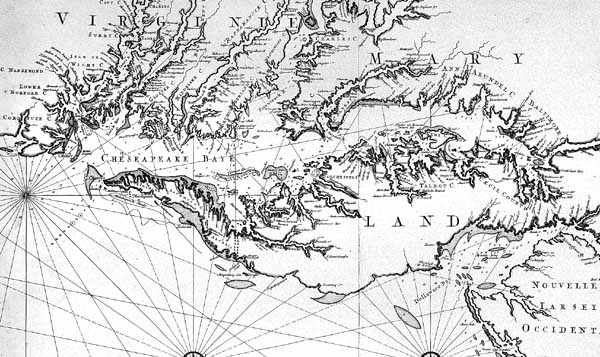 In 1608 the English explorer Capt. John Smith (Smith, John) sailed into Chesapeake Bay and stayed for several weeks to map the shoreline. With reference to the countryside around the bay, Smith exclaimed, “Heaven and earth seemed never to have agreed better to frame a place for man's habitation.”
In 1608 the English explorer Capt. John Smith (Smith, John) sailed into Chesapeake Bay and stayed for several weeks to map the shoreline. With reference to the countryside around the bay, Smith exclaimed, “Heaven and earth seemed never to have agreed better to frame a place for man's habitation.”In 1632 Cecilius Calvert was granted a charter for the land as a haven in which his fellow Roman Catholics might escape the restrictions placed on them in England. The first governor of the proprietary colony, Leonard Calvert (Calvert, Leonard), the younger brother of Cecilius, landed the founding expedition on St. Clements Island in the lower Potomac in March 1634. The first settlement and capital was St. Marys City. Aware of the mistakes made by Virginia's first colonists, Maryland's settlers, rather than hunt for gold, made peace with the local Native Americans and established farms and trading posts, at first on the shores and islands of the lower Chesapeake. The field hands included indentured labourers working off the terms of their passage and, after about 1639, African slaves. The most important crop was tobacco. Roads and towns were few, and contact with the English-model manor houses was largely by water.
 The Calvert family provided for religious freedom in the colony, and this was formalized by the General Assembly in 1649 in an Act Concerning Religion, later famous as the Act of Religious Toleration. It granted freedom of worship, though only within the bounds of Trinitarian Christianity. One of the earliest laws of religious liberty, it was limited to Christians and repealed in 1692. Commercial disputes with Anglican Virginia and boundary quarrels with Quaker Pennsylvania and Delaware did not affect this tolerance. Puritan (Puritanism) ascendancy in England (1648–60) caused only brief turmoil. A 1689 rebellion by Protestants overthrew the proprietary officers, leading to an interval of crown rule in the royal colony of Maryland (1692–1715). During that period the Church of England (England, Church of) was formally established. In 1715 Maryland once again became a proprietary colony of the Calverts, who had converted to Protestantism. Maryland nonetheless remained a haven for dissidents from sectarian rigidity in other colonies.
The Calvert family provided for religious freedom in the colony, and this was formalized by the General Assembly in 1649 in an Act Concerning Religion, later famous as the Act of Religious Toleration. It granted freedom of worship, though only within the bounds of Trinitarian Christianity. One of the earliest laws of religious liberty, it was limited to Christians and repealed in 1692. Commercial disputes with Anglican Virginia and boundary quarrels with Quaker Pennsylvania and Delaware did not affect this tolerance. Puritan (Puritanism) ascendancy in England (1648–60) caused only brief turmoil. A 1689 rebellion by Protestants overthrew the proprietary officers, leading to an interval of crown rule in the royal colony of Maryland (1692–1715). During that period the Church of England (England, Church of) was formally established. In 1715 Maryland once again became a proprietary colony of the Calverts, who had converted to Protestantism. Maryland nonetheless remained a haven for dissidents from sectarian rigidity in other colonies.By the 1660s the Protestant majority in Maryland came to resent the colony's Roman Catholic leadership in St. Marys City. As the population centre shifted to the north and west, the capital was moved to Protestant-dominated Anne Arundel Town (now Annapolis) in 1694. In 1729 Baltimore was founded. Maryland's dominant “country party” early resisted British efforts to make the colonies bear more of the costs of government. Frederick county repudiated the Stamp Act in 1765, and in 1774, the year after the Boston Tea Party, a ship loaded with tea was burned at an Annapolis dock.
The long-standing dispute between Maryland and Pennsylvania over their common border was settled in 1767 when Great Britain recognized latitude 39°43′ N as the legal boundary. The boundary was named the Mason and Dixon Line for its surveyors. Thereafter, this line came to be regarded as the traditional division between the North and the South.
Marylanders took an active part in the American Revolution. Maryland is sometimes called the “Old Line State” in honour of the Maryland troops who served with Gen. George Washington. Among the most-reliable troops in the Continental Army, they were often given difficult tasks; Washington called them “The Maryland Line.” The Continental Congress, often on the move to avoid British troops, spent a winter in Baltimore. At the close of the war, it convened in Annapolis, where it accepted Washington's resignation from the army and ratified the Treaty of Paris (1783), which acknowledged the independence of the colonies.
Postwar problems included the disposition of confiscated loyalist property, the struggle for paper money, and debtor relief. Maryland's controversy with Virginia over the use of the Potomac and lower Chesapeake Bay, resulting in the Compact of 1785, led toward the Constitutional Convention (1787), as did the Annapolis Convention of 1786, at which Maryland was not represented. Luther Martin (Martin, Luther) distinguished himself as a representative of Maryland at the Constitutional Convention. Maryland ratified the U.S. Constitution (Constitution of the United States of America) on April 28, 1788, the seventh state to do so. It also ceded territory and advanced money for public buildings to help form the District of Columbia (Washington) (1791).
The state
When harassment on the high seas and other factors brought on the War of 1812 (1812, War of), Baltimore clippers, sailing as privateers, dealt more than equal punishment to British ships. In 1814 the British troops who had burned the principal government buildings in Washington, D.C., were repulsed in their attempts to inflict similar punishment on Baltimore. Francis Scott Key (Key, Francis Scott), a Georgetown lawyer and an eyewitness to the futile bombardment of Fort McHenry by the British in Baltimore's harbour, wrote the four eight-line stanzas that, set to existing music, became the national anthem, "The Star-Spangled Banner (Star-Spangled Banner, The)," in 1931.
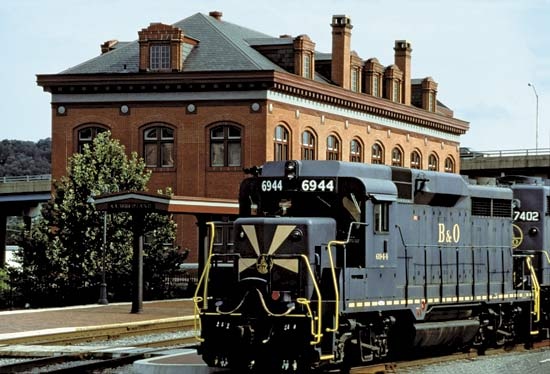 With peace, Maryland and the rest of the country concentrated on making improvements in transport and communication. The Cumberland Road, or National Road, the first road to cross the Appalachians, was completed to Wheeling, Va. (later W.Va.), in 1818. In 1828 workers began construction on the first U.S. passenger railroad, the Baltimore and Ohio (Baltimore and Ohio Railroad), and on the Chesapeake and Ohio Canal, from Washington to Cumberland. The following year, the Chesapeake and Delaware Canal, long under construction across the northern part of the Delmarva Peninsula, was completed. It connected the Delaware River to Chesapeake Bay. The country's first intercity telegraph line was constructed between Washington, D.C., and Baltimore in 1843–44. In 1845 the U.S. Naval Academy was founded on the Severn River in Annapolis.
With peace, Maryland and the rest of the country concentrated on making improvements in transport and communication. The Cumberland Road, or National Road, the first road to cross the Appalachians, was completed to Wheeling, Va. (later W.Va.), in 1818. In 1828 workers began construction on the first U.S. passenger railroad, the Baltimore and Ohio (Baltimore and Ohio Railroad), and on the Chesapeake and Ohio Canal, from Washington to Cumberland. The following year, the Chesapeake and Delaware Canal, long under construction across the northern part of the Delmarva Peninsula, was completed. It connected the Delaware River to Chesapeake Bay. The country's first intercity telegraph line was constructed between Washington, D.C., and Baltimore in 1843–44. In 1845 the U.S. Naval Academy was founded on the Severn River in Annapolis.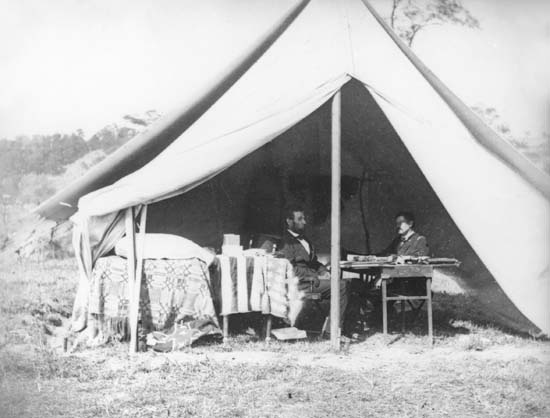 The Civil War, however, arrested Maryland's progress. Landed gentry and residents of the Eastern Shore supported the secessionist South, while workingmen and western Marylanders stood up for the Union; a third faction favoured neutrality. In 1861 federal troops occupied Baltimore and Annapolis, and martial law was imposed in this border state. Confederate armies mounted three major invasions of Maryland territory in successive summers; they were checked at Antietam (Antietam, Battle of), they met full defeat at Gettysburg (Gettysburg, Battle of), Pa., and their threat to Washington, D.C., was dissipated in 1864. The constitution of 1864 abolished slavery and removed power from the rural aristocracy. The more-cautious constitution of 1867 remains in force.
The Civil War, however, arrested Maryland's progress. Landed gentry and residents of the Eastern Shore supported the secessionist South, while workingmen and western Marylanders stood up for the Union; a third faction favoured neutrality. In 1861 federal troops occupied Baltimore and Annapolis, and martial law was imposed in this border state. Confederate armies mounted three major invasions of Maryland territory in successive summers; they were checked at Antietam (Antietam, Battle of), they met full defeat at Gettysburg (Gettysburg, Battle of), Pa., and their threat to Washington, D.C., was dissipated in 1864. The constitution of 1864 abolished slavery and removed power from the rural aristocracy. The more-cautious constitution of 1867 remains in force.Since 1865
 After the Civil War, Maryland prospered. The state was first an important entrepôt for raw materials from, and consumer goods to, the South and Midwest and became a growing centre of industry that rarely was controlled from within the state. The port of Baltimore flourished as the most inland port on the East Coast with the most-direct links by railroad to the growing Midwest. Excesses that had won Baltimore the epithet “mob town” gradually were quieted.
After the Civil War, Maryland prospered. The state was first an important entrepôt for raw materials from, and consumer goods to, the South and Midwest and became a growing centre of industry that rarely was controlled from within the state. The port of Baltimore flourished as the most inland port on the East Coast with the most-direct links by railroad to the growing Midwest. Excesses that had won Baltimore the epithet “mob town” gradually were quieted.Increasingly, the character of Maryland began to change because of its proximity to the seat of national government. The state became a major centre for federal installations, both military and civilian, during World Wars I and II and afterward; most famously, it found itself home to the presidential weekend retreat called Camp David, in Catoctin Mountain Park. But most important was the radically different face of the Maryland suburbs of Washington, D.C., which reflected change not only in the greater numbers of people but also in their unusually high educational and economic status.
When the United States took its first census in 1790, the centre of population was found to be on the eastern shore of Maryland. That site has long since moved far to the country's west. For many years Maryland remained, for all its lack of size, as close to a median or model for the whole 50 states as any other state can claim to be; it is sometimes called “America in miniature.” H.L. Mencken spoke of these qualities of Maryland in an essay describing it as the most “average” of states.
By the early 21st century, however, Maryland was anything but average. It had one of the highest median family incomes among the states and one of the lowest poverty rates. Politically, the dominating population of the Baltimore-Washington urban corridor made it a solidly Democratic state in national elections. The Baltimore-Washington metropolitan area was among the largest in the country. The Maryland economy was highly diversified, and the presence of major federal research laboratories, libraries, and agencies—owing to the state's proximity to Washington, D.C.—made the economy among the country's strongest. The rise of Maryland in the “new economy,” based on information technology and knowledge, placed it among the top states in terms of its global orientation, knowledge-based jobs, and level of education of its people.
Additional Reading
Maryland's physical and human geography is discussed in Eugene L. Meyer, Maryland Lost and Found—Again (2003); and James E. DiLisio, Maryland: A Geography (1983). Writers' Program of the Works Projects Administration in the State of Maryland, Maryland: A Guide to the Old Line State (1940, reissued 1973), also available in a newer version by Earl Arnett, Robert J. Brugger, and Edward C. Papenfuse, Maryland: A New Guide to the Old Line State, 2nd ed. (1999), includes much historical information. Two useful atlases are DeLorme Mapping Company, Maryland, Delaware Atlas & Gazetteer, 4th ed. (2004), which details the state's topography; and Raymond, Parish, Pine & Plavnick, The State of Maryland Historical Atlas (1973). Hamill Kenny, The Placenames of Maryland: Their Origin and Meaning (1999), combines geography and local history. Joseph L. Arnold, Maryland: Old Line to New Prosperity (2003), focuses on the state's economic conditions and industries. Politics and government are addressed by George H. Callcott, Maryland & America, 1940 to 1980 (1985). Useful sources on the Chesapeake Bay include Larry S. Chowning, Chesapeake Legacy: Tools and Traditions (1995); Tom Horton, Bay Country (1994); Tom Horton and William M. Eichbaum, Turning the Tide: Saving the Chesapeake Bay (1991); Gilbert C. Klingel, The Bay (1951, reprinted 1984); and Deane Winegar, Longstreet Highroad Guide to the Chesapeake Bay (2000).Historical works include Carl Bode, Maryland: A Bicentennial History (1978); Aubrey C. Land, Colonial Maryland, a History (1981); Robert J. Brugger, Maryland: A Middle Temperament, 1634–1980 (1988); Harold R. Manakee, Maryland in the Civil War (1961); and J.T. Marck, Maryland, the Seventh State: A History, 4th ed. (1998). Ongoing research is published in Maryland Historical Magazine (quarterly). The standard source on the history and geography of Baltimore is Sherry H. Olson, Baltimore: The Building of an American City, rev. and expanded bicentennial ed. (1997).